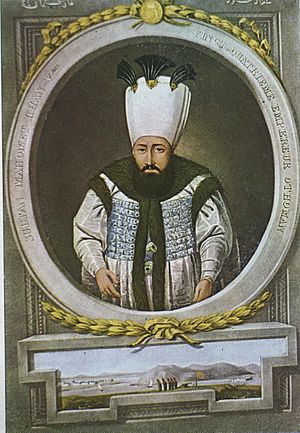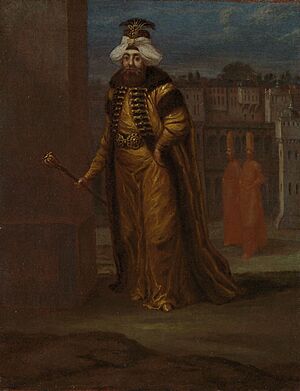Mahmud I facts for kids
Quick facts for kids Mahmud I |
|||||
|---|---|---|---|---|---|
| Ottoman Caliph Amir al-Mu'minin Custodian of the Two Holy Mosques Sultan of the two lands, Khagan of the two seas |
|||||
 |
|||||
| Sultan of the Ottoman Empire (Padishah) | |||||
| Reign | 1 October 1730 – 13 December 1754 | ||||
| Predecessor | Ahmed III | ||||
| Successor | Osman III | ||||
| Born | 2 August 1696 Edirne Palace, Edirne, Ottoman Empire |
||||
| Died | 13 December 1754 (aged 58) Topkapı Palace, Constantinople, Ottoman Empire |
||||
| Burial | Tomb of Turhan Sultan, New Mosque, Istanbul, Turkey | ||||
| Consorts |
|
||||
|
|||||
| Dynasty | Ottoman | ||||
| Father | Mustafa II | ||||
| Mother | Saliha Sultan | ||||
| Religion | Sunni Islam | ||||
| Tughra |  |
||||
Mahmud I (born August 2, 1696 – died December 13, 1754) was the Sultan of the Ottoman Empire from 1730 to 1754. He was also known as Mahmud the Hunchback because of a curve in his spine. Mahmud became sultan after a big uprising called the Patrona Halil rebellion. During his rule, the Ottoman Empire was involved in wars in Persia and Europe. He often let his top officials, called viziers, handle government tasks. Mahmud also enjoyed writing poetry in his free time.
Contents
Early Life and Education
Mahmud I was born at Edirne Palace on August 2, 1696. His father was Mustafa II, who was also a sultan. His mother was Saliha Sultan. Mahmud was the older half-brother of Osman III, who would later become sultan too.
He spent his childhood in Edirne, where his father often lived. Mahmud began his education in May 1702. When his father was removed from the throne, Mahmud was brought to Istanbul. There, he was kept in a special part of the palace called the Kafes. He lived there for 27 years.
Life in the Kafes could be difficult, but Mahmud still found ways to learn and grow. He enjoyed playing chess, writing poetry, and studying music.
Becoming Sultan: The Patrona Halil Rebellion
On September 28, 1730, a man named Patrona Halil led a group of soldiers called Janissaries. They started an uprising in Constantinople because they were unhappy with the current sultan, Ahmed III. The rebels marched to the Topkapı Palace. They demanded that the Grand Vizier (the sultan's chief minister) be killed and that Ahmed III step down.
Ahmed III agreed to their demands. He had the Grand Vizier killed and allowed his nephew, Mahmud, to become the new sultan. Mahmud's official rule began on November 25, 1730. After he took power, Istanbul was placed under strict control. About two thousand people suspected of being involved in the rebellion were arrested. Some were punished, and others were sent away from the city.
Mahmud's Rule and Challenges
At first, the rebels still had a lot of power. Patrona Halil even rode with the new sultan to a special mosque for a ceremony. Halil, who was a common soldier, even told the sultan who should be appointed to important government jobs. He even tried to make a Greek butcher, who had helped him, a ruler of a region called Moldavia.
However, Mahmud I's supporters and other powerful officials worked together to end the rebellion. On November 24, 1731, Patrona Halil was killed by the sultan's order. About 7,000 of his supporters were also punished. This finally brought the rebellion to an end after more than a year.
Mahmud I often let his viziers handle the day-to-day running of the government. He spent much of his own time writing poetry. His reign was largely shaped by wars. He faced conflicts in Persia against the rising power of Nader Shah. He also fought a major war in Europe, known as the Austro-Russian-Turkish War (1735–1739).
Fires in Istanbul
During Mahmud I's reign, Istanbul faced several large fires. In January 1750, a fire started near the Ayazma gate and burned for 19 hours. Many shops, houses, and mansions were destroyed. The sultan removed his current Grand Vizier and appointed a new one to deal with the disaster.
Another big fire broke out in March 1750, burning down many market areas. The sultan used money from the treasury to help repair the damaged parts of the city.
Building and Culture
Mahmud I was also interested in building new structures. In 1740, he began building the Cağaloğlu Bath, a large public bathhouse. He also had new houses built on empty land nearby, creating a new neighborhood.
He established three libraries in Istanbul. The first one was opened with a ceremony in the courtyard of the Hagia Sophia Mosque. This library held 4,000 books. Mahmud I sometimes visited the library himself to listen to scholars discuss religious texts.
Relations with Other Empires
Mughal Empire
A powerful leader named Nader Shah from Persia launched a major attack on the Mughal Empire in India. This created an opportunity for the Ottoman Empire. Sultan Mahmud I started a war with Persia, known as the Ottoman–Persian War (1743–46). The Mughal Emperor Muhammad Shah worked closely with the Ottomans during this time. This alliance continued until Muhammad Shah died in 1748.
Safavid Empire
In March 1741, an ambassador from Nader Shah's government in Iran visited Istanbul. He came with 3,000 people and guards to try and keep the peace between the two empires. He brought many valuable gifts, including fabrics with jewels, ten elephants, and expensive weapons. Special arrangements were made to bring the elephants into Istanbul.
However, relations between the Persian (Afsharid) Empire and the Ottoman Empire became very tense. In February 1743, a prince from the old Safavid dynasty, who was held by the Ottomans, was sent to the Persian border with troops. This added to the growing conflict between the two empires.
Death and Legacy
Mahmud I suffered from a health problem called a fistula. His health got worse during a harsh winter. On Friday, December 13, 1754, he went to attend the Friday prayer. After the prayer, he was returning to his palace when he collapsed on his horse. He died on the same day.
He was buried in the Turhan Sultan Mausoleum in the New Mosque, located in Eminönü, Istanbul. Mahmud I had 11 consorts (partners) but did not have any children during his 24-year reign.
Family
Mahmud I had several consorts, but he did not have any children. Some of his known consorts include:
- Hace Ayşe Kadın: She was his first chief consort until her death in 1746. She built a school near the Fatih Mosque.
- Hatem Kadın: She became the chief consort after Ayşe Kadın died and remained so until Mahmud I's death in 1754.
- Hace Alicenab Kadın: She built schools and fountains in the Fatih area.
- Hace Verdinaz Kadın: She built a school and fountains in different parts of Istanbul.
- Hatice Rami Kadın: She built a school and a fountain in Beşiktaş.
- Tiryal Kadın
- Raziye Kadın
- Meyyase Hanim
- Fehmi Hanim
- Sirri Hanim
- Habbabe Hanim
See also
 In Spanish: Mahmud I para niños
In Spanish: Mahmud I para niños


